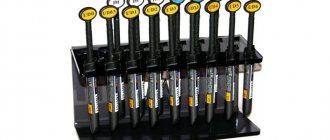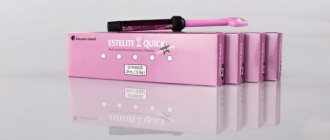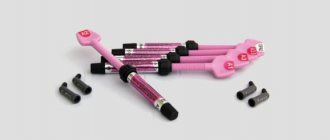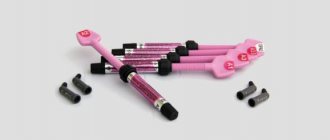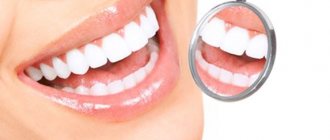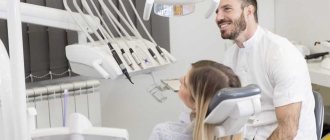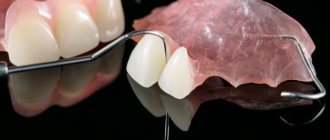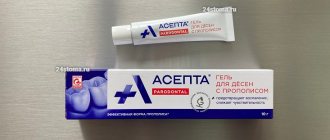Resistant teeth with problematic immature roots pose a serious problem. And external damage causes the condition of such complex teeth to worsen. If you postpone a visit to the dentist or receive poor-quality treatment, necrosis of the hard tissues of the tooth may develop, causing severe and rapidly progressing pulpitis.
The best treatment method in this case is apexification using calcium hydroxide. However, these materials have a number of disadvantages.
Through extensive laboratory research, a unique MTA material was developed. But its high price forces many dentists to refuse to use it in their practices, despite its excellent properties.
the innovative material Trioxident was created, which is an analogy of MTA and has practically replaced it in practical dentistry. It is much more affordable, and in quality is in no way inferior to its predecessor.
The new material is highly effective and improves the quality of retrograde fillings. Compact and airtight packaging allows you to work comfortably with the drug.
Composition and release form
Trioxidant consists of ideally selected active ingredients.
Increased alkalinity is obtained from the oxides of calcium, silicon and aluminum. These elements give the material strength, the ability to hermetically seal defects in the canal, prevent bacteria from entering the tooth cavity, and the solubility of the drug remains low, which allows for high biocompatibility. Copper and calcium hydroxide serves as a bacteriostatic additive. Bismuth oxide provides excellent radiopacity.
Release forms:
- powder;
- dropper bottle.
Additional equipment:
- mixing form;
- spatula for mixing;
- set of tools for retrograde filling;
- tubes made of F-4D plastic, 4 and 8 mm;
- detailed instructions for use;
- box - case.
Application area
Trioxidant, in its own way, is a universal remedy:
- used for retrograde filling;
- used as a therapeutic pad for pulp isolation;
- used to close root canal perforations;
- The material fills the upper apex part of the dental canal.
Properties and capabilities
The material hardens in the canal for four hours, after a day it is completely hardened. This gives it advantages over all existing analogues.
The hardening process occurs in three stages:
- interacting with water, calcium oxide is converted into calcium hydroxide, which provides increased alkalinity;
- due to the saturation with calcium hydroxide, all elements are converted into a homogeneous elastic mass;
- calcium hydroxide saturates the mixture of the resulting calcium silicate, thereby increasing the plasticity of the mass.
Modern treatment methods involve retrograde root covering. To improve the quality of this procedure, Trioxydent material is ideal.
They fill and close the upper base of the dental canal, close the perforation of the root canal, and cover the tooth pulp. The drug has excellent bactericidal properties and hermetically covers drilled cavities.
Trioxident - closing root canal perforations
Trioxydent is a dental water-soluble material for retrograde filling and correction of defects in the root canals of teeth.
PURPOSE
It is used for retrograde filling, for filling the upper apical part of the canal with incomplete root formation, for closing root canal perforations, and also as a therapeutic-isolating pulp coating.
COMPOSITION AND MAIN PROPERTIES
The main components of the water-soluble dental material Trioxident are oxides of calcium, silicon, and aluminum.
When mixing the powder with distilled water in a weight ratio of 3:1, an easy-to-use paste is formed that does not lose plasticity for 10-15 minutes at room temperature 18-23C and humidity 50-10%. To obtain a plastic paste, a plasticizer is added to the powder to prevent rapid drying of the material on the mixing plate.
The material hardens in the canal within 24 hours.
Curing of the material occurs gradually in three stages: first, calcium oxide reacts with water, turning into calcium hydroxide, which ensures high alkalinity of the material (pH 12.8). From a solution saturated with calcium hydroxide, the latter is released in an amorphous state and envelops the particles of the radiopaque filler, turning the mixture of components into a cohesive mass. The calcium hydroxide particles then compact the mass of calcium silicate formed, increasing the mechanical strength of the resulting cement.
The basis of the Trioxidant filling material is: - calcium hydroxide, which stimulates the processes of apex and osteogenesis in the treatment of teeth with unformed roots, stops bone tissue resorption;
when covering the pulp, it stimulates the formation of a dentinal bridge; has bactericidal properties. - copper-calcium hydroxide is an active bacteriostatic additive of a chemical nature common to the main components.
The material has high biocompatibility, low solubility and high mechanical strength, and also ensures tight closure of the channels and impermeability to bacteria.
The use of instruments for retrograde filling allows you to introduce paste into the canal, eliminating the entry of excess material into the periapical area, and also work with a small amount of material, directing all the material directly to the defect area.
RELEASE FORM
Powder 0.5 g x 10 pcs
Application diagram
The material is kneaded on a glass plate using a clean spatula. The required dose of powder and purified water are combined in proportions of 3:1. The mixture is brought to a plastic consistency. The resulting plastic paste is used to fill the defect area. As the material dries, additional water can be added (once).
When restoring perforation, it is recommended to carefully prepare the dental canals. After this, the channels are treated with sodium hypoporite and washed well. Having established the affected area, obturation of all canals is performed. The resulting paste is applied directly to the affected area and strengthened using an ultrasound attachment.
During root apexification, initial preparation of the affected canal is carried out. Having removed all contaminants, the canal is washed and dried with dry pins. The next stage is disinfection.
Then the potassium hydroxide-based paste is carefully applied. It should remain in the root canal for a week. After this period, the paste is removed and the canal is washed with sodium hypochloride.
Instructions for Trioxidant
Material stored or transported at low temperatures must be kept at room temperature for at least 1 hour before use.
The dental material Trioxidant is mixed at room temperature 18-23°C and humidity 50±10% on a dry glass plate with a dry, clean spatula in a powder/distilled water ratio of 3:1.
To do this, a dose of powder (0.3 g) must be mixed with 3 drops (0.10-0.11 g) of distilled water, a dose of powder (0.5 g) must be mixed with 4 drops (0.17- 0.18 g) distilled water. Mix for 30-40 seconds until a plastic paste is obtained, which is placed in the defect area using special tools from the kit. If plasticity is lost (after 10-15 minutes), a small amount of distilled water can be added to the paste once and mixed.
To restore perforation after resorption, it is necessary to prepare the canals. The channels, cleared of sawdust and half-life products, treated with sodium hypochlorite (Belodez 3%) and washed with water, are dried using paper points. Then the root canal defect zone is established and all canals in the apical zone from the established defect zone are obturated.
The trioxidant is placed in the defect area and compacted. The material can be condensed using a large ultrasonic nozzle without spraying water, at medium power.
Using the radiograph, you must ensure that you have placed the Trioxidant material correctly. Then the remaining part of the canals is obturated, isolated with lining material, and the tooth crown is restored.
To restore perforation of the lateral root canals, it is necessary to prepare the canals. The channels, cleared of sawdust and half-life products, treated with sodium hylochlorite (Belodez 3%) and washed with water, are dried using paper points. Then the site of perforation is isolated and all canals located apically from the perforation are obturated.
The trioxidant is placed into the defect area and compacted using a small amalgam plunger and a cotton swab or paper points. The material can be condensed using a large ultrasonic nozzle without spraying water, at medium power.
Using the radiograph, you need to make sure that you have placed the material correctly. Then the remaining part of the canals is obturated, isolated with lining material, and the tooth crown is restored.
To apexify the root, it is necessary to prepare the canals. The channels, cleared of sawdust and half-life products, treated with sodium hypochlorite (“Belodez 3%”) and washed with water, are dried using paper points. Then, for disinfection, a paste based on calcium hydroxide (Apexdent without iodoform) is placed in the canal for a week.
After a week, the paste is removed from the root canal system using root canal instruments and irrigating the canal with sodium hypochlorite solution. The canal is dried with paper points.
The trioxidant is placed in the apex and compacted using a small amalgam plunger and a cotton swab or paper points. The material can be condensed using a large ultrasonic nozzle without spraying water, at medium power.
Using an x-ray, you need to ensure that you have correctly placed the material that is to remain as a permanent root canal filling. Then the remaining part of the canals is obturated, isolated with lining material and the crown is restored.
For retrograde filling of the root apex, under local anesthesia, access to the root apex is provided (the mucoperiosteal flap is peeled off), resection of the root apex is performed, and a cavity for retrograde filling is formed using an ultrasonic tip with special diamond tips.
After ensuring hemostasis, the cavity in the tooth root is filled with the resulting Trioxident paste using instruments and plastic attachments. The bone defect is replaced with osteoplastic material, the flap is placed in place and fixed.
To cover the pulp, the cavity is prepared using burs at high speed with constant irrigation with water. If caries is present, the carious dentin is removed using a round handpiece bur at low speed or using hand instruments. The prepared cavity is washed with sodium hypochlorite solution. bleeding is stopped with a cotton swab soaked in hemostatic fluid (Capramin).
A small amount of Trioxydent is then applied to the exposed area using a small applicator with a ball at the end. Excess moisture in the work area is removed using a moistened cotton swab. A small amount of flowable compomer liner material or glass ionomer light-curing liner material is then applied and cured.
The remaining surfaces of the cavity are treated with dentin etching gel for 15 seconds and washed thoroughly. Then the cavity is carefully dried, leaving the dentin slightly damp, but not wet, the adhesive is applied and polymerized, after which the restoration is completed.
